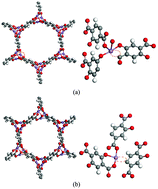A DFT study on the effect of oxygen vacancies and H2O in Mn-MOF-74 on SCR reactions†
Abstract
As one of the main air pollutants, nitrogen oxides (NOx) have serious effects on human health and the environment. In our previous study, we found that Mn-MOF-74 shows excellent catalytic performance for the selective catalytic reduction (SCR) reaction with NH3 being the reductant (NH3-SCR) at low temperature. To obtain a further understanding of the NH3-SCR mechanism in Mn-MOF-74, in this paper, we investigated two important parts of the NH3-SCR process in Mn-MOF-74 using the density functional theory (DFT) method. On the one hand, the structural characteristics of two types of oxygen vacancies of Mn-MOF-74, namely carboxyl oxygen vacancies and hydroxyl oxygen vacancies, and their adsorption properties to reaction species were calculated. It was found that the oxygen vacancies not only activate the reaction species, but also promote the desorption of NO2 molecules from metal sites for the subsequent rapid SCR reactions. On the other hand, we studied the effect of H2O on the structural stability and catalytic performance of Mn-MOF-74. It was found that the interaction of Mn–O bonds was weakened by H2O. Therefore, the influence of H2O should be considered for the future design of MOF-based catalysts for the SCR process.



 Please wait while we load your content...
Please wait while we load your content...